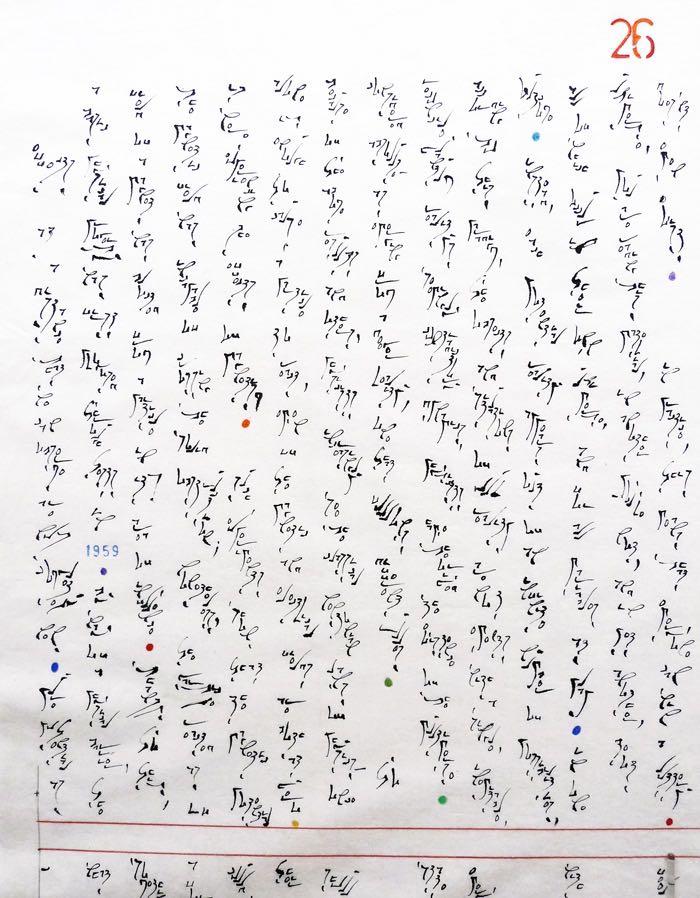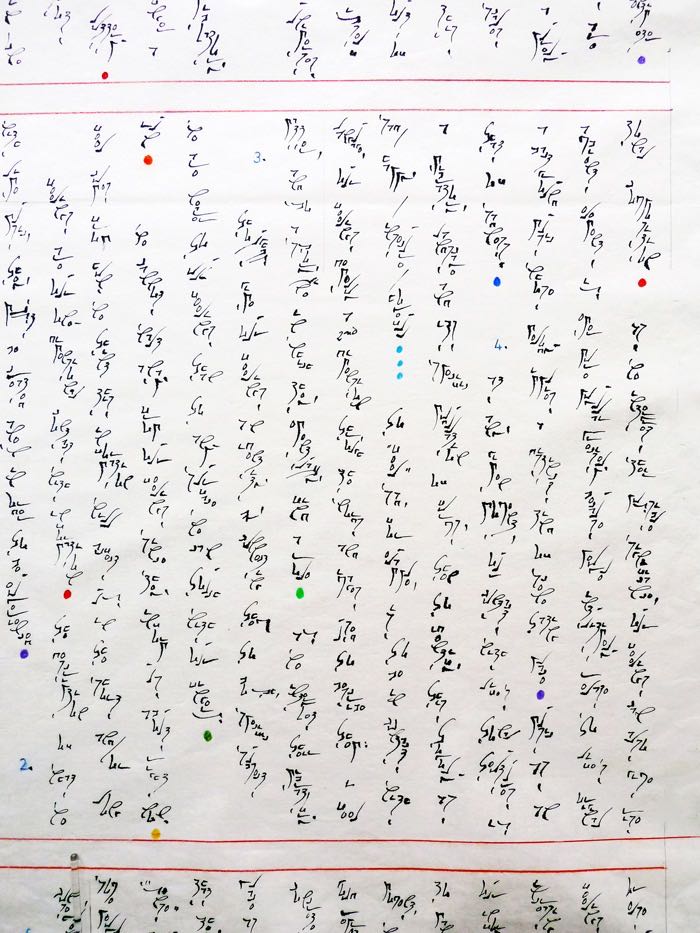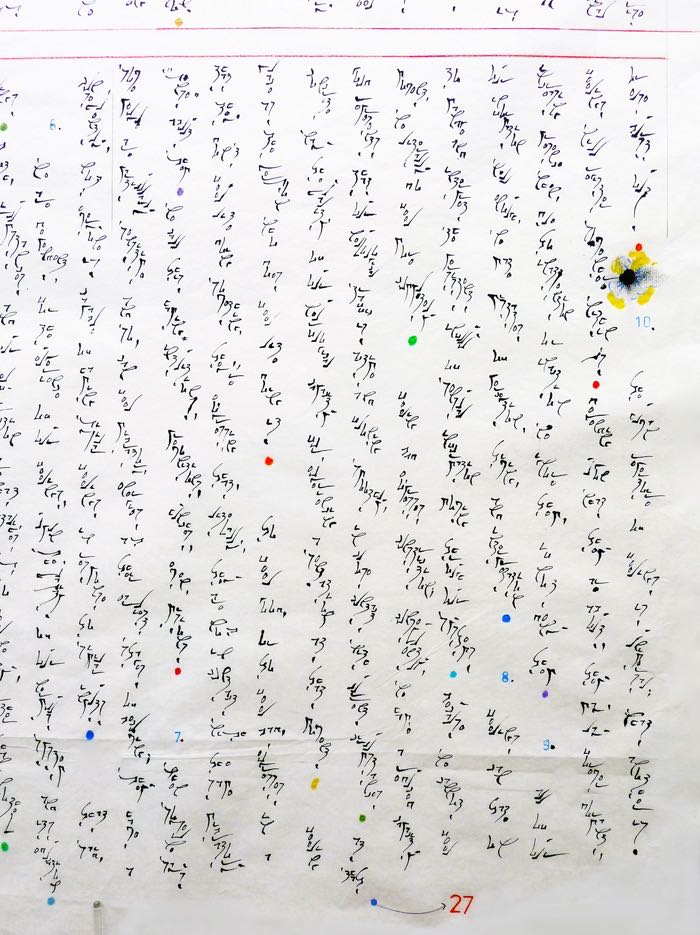Buy HD e-Books & Text —— www.ccelian.com
the Art of Nao
Scrolls: 1 . 2a . 2b . 3 . 4 . 5 . 6 . 7 . 8 . 9 . 10 . 11 . 12 . 13 . 14 . 15 . 16 . 17 .
18 . 19 . 20 . 21 . 22 . 23 . 24 . 25 . 26 . 27 . 28 . 29 . 30 . 31 . 32 . 33 . 34 .
< Scroll 25 ____________________________________________________ Scroll 27 >


Scroll 26 . 66 x 132 cm ~26 x ~ 52 inches
_______________________

Scroll 26-section 1
Effects at a distance that we can observe are not completely new. Pure potential as a basic physical property was first proposed through tests in 1959. By way of a physical barrier, the field of a magnet was blocked from a particle in its area of influence. Thanks to this, the magnetic field was incapable of crossing the solid obstruction; nonetheless, the particle reacted as if it were experiencing the effects of magnetism.
Such experiments showed that the magnetic potential alone is enough to cause a particle to react, even when the magnetic and electric fields are both at zero. Because of the above results and others, physicists increasingly see the classical Newtonian laws of physicality—once considered absolute—as emerging from a deeper reality, one that follows different rules.
To reconcile quantum reality’s seemingly contradictory dynamics, physicists have theorized the existence of the multiverse. According to this paradigm, the objects and situations of our reality are not events with a single, inevitable, outcome. Instead, each potential reality appears out of an infinite number of possibilities, all of which occur in their own universe, and for all variables at play. In one universe, you are reading this material, in another, you’re not, and in yet another, text doesn’t even exist.
________________

Scroll 26-section 2
In practice, this means that everyone can win a lottery. Since all sets of numbers have a chance at being selected somewhere, it is no longer a question of picking the winning numbers; instead, the skill would be in finding a vibratory way to occupy the universe where your chosen numbers are selected.
As it is, the field of physics has for some time included theories of universes with holographic natures, such that each piece of the universe contains information about itself as a whole. Further, a recent theory describes the possibility of something coming out of nothing—particles being extracted from a vacuum. With only a little stretch, this sounds like imagination’s capacity for transforming materiality.
The ultra-small scales below even the quantum world explain part of our ability to access potential being in a purely conceptual way. Infinitesimal size is especially striking in string theories.
“Strings” are hypothetical sub-quantum particles of 10-33 cm: that is, one-millionth of a billionth, of a billionth, of a billionth, of a centimeter.
_______________

Scroll 26-section 3
[(Omitted) All quantum properties would thus arise from the various vibrations of these one-dimensional strings.]
According to the above worldviews, it is plausible to consider that reality is simply what exists under a given set of circumstances. Change them—for example, by your thoughts on something—and you occupy a different reality. This kind of arrangement is essentially a form of simplicity and economy.
When you add up all of the variables that could exist, across all beings and spaces, plus how much energy it would take for each of their combinations to be experienced, then it only makes practical sense that any reality should be virtual and conceptual instead of completely solid.
29 Feeling Feelings
- 1. Feelings are timeless; there is no such state as a young or an old version of happiness, of love, of sadness, of solitude, etc. Every feeling is equally fresh whenever it appears, regardless of how it occurs.
Feelings cannot age because they are made from our nerves’ activations. Just as with live music, they must be created anew in order to be experienced.
__________________

Scroll 26-section 4
- 2. Feelings are our one-dimensional contact with information. The description of what we feel comes from how we think this information will affect us in the short &/or long run. We cannot walk away from our feelings since they inform us about right now. We are nearer to our feelings than to any surface that we can touch with our fingers.
- 3. Thoughts give our feelings an identity by connecting them to both, specific subject matter, and to a storyline in which they eventually find a role. As we interpret their vibratory language, our feelings develop a 2nd dimension through the words and images used to describe them: I feel sad / happy / insecure /hopeful… To “feel” sad, for example, is to be in contact with a vibratory landscape and its specific modulation of form, then to identify this topology as that of sadness.
- 4. At any given moment, our contact with life's tonal textures is a background music whose melody implies a distinct kind of scene taking place. Music as an ambient element is ever more popular precisely because people intuitively relate to life’s original tonal composition. As we interpret their possible significance, our feelings can also give rise >
________________

Scroll 26-section 5
> to feelings about our feelings. Expanding points of contact then lead to the arrival of ever more feelings, which in some can eventually become overwhelming. Many people keep their feelings in check out of fear that such a feeling cascade will carry them away. “Getting carried away,” however, is sometimes the best thing that we can do in order to keep flowing.
5. Feelings convince us of their vital importance because of an automatic logic that states: a thing must already exist before one can feel (touch) it. Feelings, however, are not always as significant as they feel to be, no matter how strongly. Some of our feelings may not represent a reality beyond our own neurological readings. These can only be dispelled by our understanding, and not by changes under the control of someone, or something else.
Feelings do not necessarily differentiate between a present event and an imagined one. Remember something that once moved you deeply and it will not be long before you are right back into that feeling place; yet it is only in virtual form. Each feeling comes out of a spectrum of all possible feelings. Both circumstances and our self direction are what catalyze us to feel one way, rather than another.
6. We are dependent, for the experience of our feelings, upon the quality of our nervous system and its education. Consequently, not everyone is capable of having similar feelings in response to similar inputs.
___________________

Scroll 26-section 6 — End of Scroll 26
That said, some people are particularly sensitive and so, can feel vibratory energies at their earliest stages of becoming; they have a "sense" about them. We call this having intuitions, premonitions, hunches, even, visions.
7. When someone says that they don't feel like doing something, they're expressing that, literally, they are not in contact with the same vibratory place as the person who does feel like doing it. To feel good, or to feel bad, expresses in a concrete way the quality of our neurological capacity for experiencing a sensation at that moment.
Feeling good represents that our neurological traffic is active and flowing smoothly, in close contact with current circumstances. At that moment, we literally do feel more completely.
Feeling bad expresses constriction; consequently, we have a reduced capacity to manage and interpret the persistent influx of sensual information moving through our systems. Because we cannot feel our information well enough, we make mistakes of perception, timing, and interpretation.
8. Feelings can take on increasing presence when, due to inattention or inaction, we ignore them, if not deny them.
9. All of our feelings will register somewhere within us. Depending upon what they are about, they may lay forever dormant, or else burst out.
10. The human repertoire of feelings is universal; what another is >
< Scroll 25 ____________________________________________________ Scroll 27 >
Scrolls: 1 . 2a . 2b . 3 . 4 . 5 . 6 . 7 . 8 . 9 . 10 . 11 . 12 . 13 . 14 . 15 . 16 . 17 .
18 . 19 . 20 . 21 . 22 . 23 . 24 . 25 . 26 . 27 . 28 . 29 . 30 . 31 . 32 . 33 . 34 .
Buy HD e-Books & Text —— www.ccelian.com
© C.C. Elian 2010 - 2016